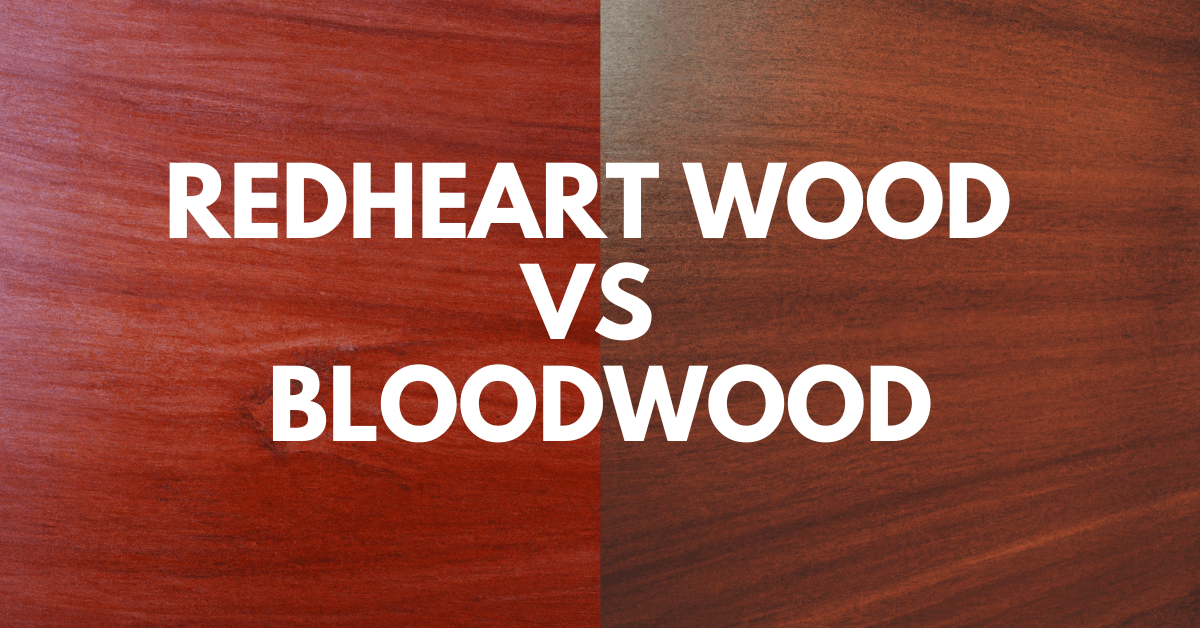Bloodwood is more hard, durable, and insect resistant than Redheart wood. Redheart wood and bloodwood are two types of wood that look quite similar to each other. Sometimes it becomes difficult to identify them on the basis of color.
Each wood species has its own characteristics, which you should know before choosing. Choosing the right wood is the first step in creating a perfect project.
What is Redheart Wood?
Redheart wood is a hard, moderately durable domestic hardwood used for furniture, cabinets, and other wood products. It is also referred to as “Chakte Kok” and comes from Southern Mexico to southern Brazil and Paraguay.
It is often prized for its beautiful, watermelon red-colored heartwood, which can range from a deep purple to a bright red.
Redheart wood is a small to medium-sized tree growing to 50–65 feet (15–20 m) tall and 1–1.5 feet (.3–.5 m) in diameter.
What is Bloodwood?
Bloodwood is a dense, dark wood, very durable, and insect-resistant hardwood, typically found in South America. Bloodwood is also known as “Satine”, It is prized for its extreme durability and long-lasting.
The “Bloodwood” got its name because when the Bloodwood tree is damaged, a fluid (which is called Sap) like blood comes out of it. Once the wood has dried, it does not release liquid.
The bloodwood tree (Araucaria araucana) is a large, evergreen tree that can grow up to 80-150 ft (25-45 m) tall and 1–1.5 feet (.3–.5 m) in diameter.
The Differences Between Redheart wood and Bloodwood
| # | Redheart | Bloodwood |
| Scientific name | Erythroxylum spp. and Simira spp. | Brosimum rubescens |
| Popularity | Less | More |
| Good For | Turned Objects | Turned Objects |
| Rot-resistant | Moderately | Extremely |
| Odor | Rubber-like smell | Mild scent |
Uses
Redheart Wood Uses
Redheart wood is a popular choice for turned objects, veneers, furniture, cabinets, and other woodworking projects. It curves easily and finishes well, so it is an excellent choice for turned objects.
Redheart wood is a great choice for flooring as it is dense and hard, which helps to protect it from scratches and dents. It requires less maintenance than other hardwoods.
Bloodwood Uses
Bloodwood is used for carving, trim, inlay, furniture, cabinets, guitars, tool handles, and turned objects. Due to its excellent vivid red color and workability, it is mostly used for making handmade art.
Bloodwood is dense and fine-grained that is used for musical instruments, It is used for making guitar bodies and necks. It can be used for all places that require durability and insect resistance.
Redheart wood or Bloodwood | Which wood is easier to work with?
Working with Redheart Wood
Redheart wood is easier to work with than bloodwood, because of its low density and weight, it is easy to handle. Turns, glues and finishes well.
Working with Bloodwood
Bloodwood sands well and finishes well, but it is extremely hard and dense. It is highly prone to blunt effects on the cutter and it dulls the machine blade. So it is important to use the right tools and make sure your tools are sharp too.
Sometimes you need to use power tools because working with hand tools can be difficult. You will also need a special blade that is suitable for the hardness of the wood.
Appearance
The Redheart wood varies from orange/pink to brownish red and Bloodwood has vivid red color or darker brownish red. Sometimes the color of Redheart wood looks very similar to Bloodwood.
Redheart wood’s vibrant color quickly fades to a reddish brown in direct sunlight while Bloodwood becomes darker (brownish red) over time when exposed to sunlight.
Rot-Resistant and durable
Bloodwood is more resistant to rot and insects than Redheart wood. Redheart is moderately resistant to fungi and insects. We can say that both Redheart and Bloodwood have better durability and rot resistance than many domestic hardwoods.
Hardness
Bloodwood is harder and heavier than Redheart. Bloodwood is twice as hard as Redheart wood on the Janka hardness scale. Redheart wood has a Janka hardness value of 1,210 lbf (5,380 N) while bloodwood has a Janka hardness value of 2,900 lbf (12,900 N).
Here are the Janka hardness values of some popular woods so that you can get an idea of the hardness of Redheart and Bloodwood.
| Wood Species | Janka Hardness |
| African Mahogany | 850 lbf (3,800 N) |
| Black Walnut | 1,010 lbf (4,490 N) |
| Koa | 1,170 lbf (5,180 N) |
| Redheart wood | 1,210 lbf (5,380 N) |
| White Ash | 1,320 lbf (5,870 N) |
| White Oak | 1,350 lbf (5,990 N) |
| Tigherwood | 2,170 lbf (9,640 N) |
| Honduran rosewood | 2,200 lbf (9,790 N) |
| Bloodwood | 2,900 lbf (12,900 N) |
| Cocobolo | 2,960 lbf (14,140 N) |
| Ipe wood | 3,510 lbf (15,620 N) |
| African Blackwood | 3,670 lbf (16,320 N) |
Availability and Price
Redheart wood and Bloodwood both are readily available. Both wood species are not listed in the CITES Appendices or on the IUCN Red List of Threatened Species.
Bloodwood is quite more expensive than Redheart wood, while Redheart Wood is available at a moderate price.
Similarities between Redheart wood and Bloodwood
Redheart and Bloodwood are both strong and durable, used for turned objects, furniture, and other wooden projects. The Janka hardness value of these woods is high.
The color of both Redheart and Bloodwood is very similar to each other, both are bright red in color. Therefore, these woods are the best alternatives to each other.
Conclusion
Both Redheart and Bloodwood are excellent choices for turned objects, but if you are looking for extremely durable and rot-resistant furniture, then Bloodwood may be the best choice for you.

